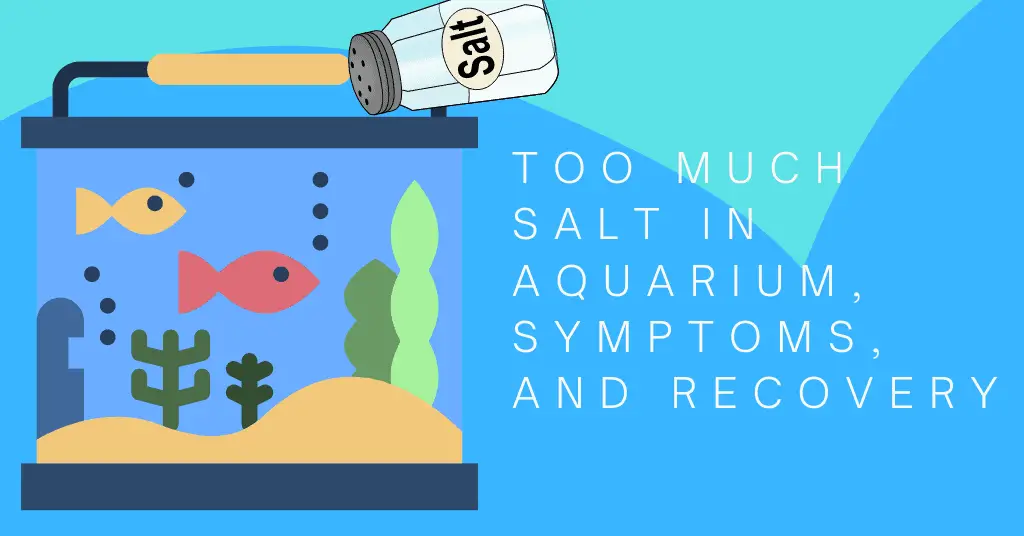Last Updated on July 2, 2022 by cmoarz
Salt does an interesting thing to fish. In high enough concentrations, it actually sucks the water out of their cells and tries to add itself in its place.
Picture this, Your fish is filled with fresh water, And your tank is filled with fresh water. When you salt your tank, which we sometimes do for a variety of reasons, You’re introducing a higher salinity count to the water in your aquarium.
The fish’s cells are trying to maintain equilibrium, so they start to take in the salt water and push out the freshwater that was inside them. This process is called osmosis.
Osmosis can be a good thing or a bad thing depending on how you look at it and what the goal is. If you’re wanting to add a little extra salt to the water for health benefits, then osmosis is working in your fish’s favor.
If, however, you’ve accidentally added too much salt to the water, it can be hazardous for your fish.

What happens when you add too much salt to an aquarium?
Table of Contents
The high concentration of salt outside their cells will cause them to dehydrate. It certainly sounds a bit weird at first and gives credence to the saying “Water water everywhere but not a drop to drink” but it’s true.
This dehydration technique is why we use salt to combat ich as an ich cyst will dry out and die long before the much larger fish is dehydrated.
In more negligible salinity levels this is fine, And determining the salinity levels is entirely up to the size of the tank, and the tolerance levels of the fish species to salt.
When we add too much salt to the water, we’re essentially doing the same thing to our fish as if we were to remove all the water from their cells and then add salt water back in its place.
This is extremely dangerous for your fish because it will cause them to go into shock, and if not treated quickly, they will die.
Their organs will begin to shut down, and they will lose the ability to swim or move properly.
Some other symptoms of salt overdose include gasping for air at the surface of the water, fins and tails becoming clamped, and an overall lethargic appearance. If you notice any of these symptoms in your fish, it’s important to take action quickly.
At extremely high salt levels, the fish may attempt to physically remove itself from the water by rushing to the surface and attempting to jump out as the salt burns them.

Removing excess salt from a freshwater aquarium
For freshwater, Most people aren’t going to accidentally overdose on their tank too badly, But overdoses do happen and luckily they’re easy enough to deal with.
Depending on how badly the aquarium is salted will change the priority of these steps.
For not-so-bad situations, where you’ve just gone slightly over proper measurements, simple water changes can effectively dilute salinity levels to a safe level.
Doing a 50% water change is typically all that’s needed as this will half the salinity levels in your aquarium.
Every subsequent water change after that should be done in smaller increments until you reach the desired salinity level.
For more serious cases, Where the salinity levels are dangerously high, You’ll want to do a series of large water changes.
Doing several 50% or even 75% changes in succession will quickly lower the salinity, but also potentially kill sensitive fish.
So that moves on to the next priority step. If your fish are in extreme partial or at risk of death from the solution, it’s important to take them out and place them in a separate holding tank with fresh water.
You’ll want to do this as quickly as possible, And keep a very close eye on them as they will be in a very weakened state.
Once the fish are all moved to the holding tank, you can begin working on fixing the main display.
For extremely high salt levels, you’ll want to do several large water changes in succession until you reach a safe level.
You can then begin acclimating your fish back into the display tank by using every acclimation process you usually like to use.
The fish may or not recover based on the severity of the initial overdose, the differences in holding water to main tank water, etc. But if you take quick action, you can save their lives.

Removing Excess Salt From Reef Tank
It’s much harder to salt overdose a reef or salt water tank for two reasons. One, The fish and coral are already high tolerance to salt, and 2, You almost certainly have a salinity refractometer for testing your water before you make a mistake.
However, it still happens from time to time. And the process for fixing a reef tank similar to that of the freshwater aquarium, but in smaller increments.
Usually fish and coral won’t need to be removed from the tank to complete this process.
Siphon out 10% of the water, and replace it with fresh. Mesure with salinity refractometer, and if it’s still too high, siphon out another 10% and replace.
You’ll want to do this until you reach the desired level.
It’s important not to go too quickly as this could shock your fish and coral, so take it slow and steady.
As with freshwater, The goal is to quickly remove the excess salt without harming your fish or coral.
About
Owner of AquariumGravel.com and also owner of actual Aquarium Gravel believe it or not! ;). Setting up beautiful aquarium sceneries and habitats since I was very young. Enjoy!
- Web |
- More Posts(290)

